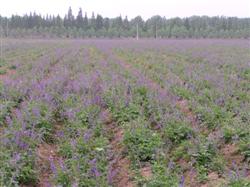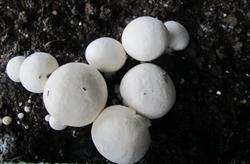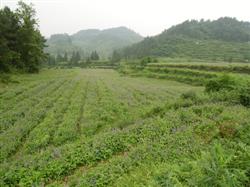How to grow Salvia miltiorrhiza? Please introduce it in detail

How to grow Salvia miltiorrhiza? Please introduce in detail the cultivation of Salvia miltiorrhiza can refer to the following methods: land selection: high temperature and dry weather at seedling stage, resulting in stagnant growth or even death of seedlings. Salvia miltiorrhiza root is deep, requires deep soil layer, good drainage, medium fertility sandy soil is better, if the soil is too fertile, ginseng root is not strong. The most avoid waterlogging, in poor drainage of low border cultivation, resulting in rotten roots. It is better that the pH of soil is near neutral. Too sandy or sticky soil is not suitable for planting. Seedling transplanting breeding: salvia miltiorrhiza planting is divided into seedling transplanting, Reed head transplanting, root transplanting. 1. Seedling transplanting 1, seedling: 1, nursery bed preparation: nursery bed and nursery field should be made of relatively fertile fine sandy loam, applying compound fertilizer 40 MUMI 70kg per mu, ploughing more than 20cm, raking fine leveling to remove stones, making beds, each bed is 1Mul 1.2 meters wide, leaving drainage ditches. Second, sowing: use seeds of about 2.5 kilograms per mu, sow the treated seeds on the seedbed in time, gently tap the ground with a big broom or shovel, then cover the wheat straw to preserve moisture, heat preservation, shade, and immediately water the wheat straw through the moisture, and pay attention to moisturizing, when the seedlings return to green, remove the wheat straw in time to prevent damaging the seedlings. Third, strong seedlings: if the soil fertility is poor, when the seedlings grow to 4-5 leaves after emergence, once combined with watering and topdressing, 10 kg urea per mu. 1. Transplanting field preparation: select a suitable field, apply compound fertilizer 20murmuri 50kg per mu as base fertilizer, turn 35cm more than deeply, flatten, open ditches, and make beds, with a width of 1m. Transplanting: winter planting and spring planting, with high yield in winter. Winter planting is carried out between Cold Dew and Frosts Descent from late October to early November. When planting, the distance between rows and plants is 20x25cm, digging or trenching, and the depth of ditch or nest is straightened by the length of seedling root, and the soil can be cultivated until the heart bud is slightly exposed. About 10000 plants are planted per mu. When planting, irrigate the right amount of fixed root water according to the soil moisture. But don't flood. two。 Reed head propagation (1) prepare to raise seedlings and transplant in the field. (2) planting of Reed head: propagation and cultivation method of Reed head: when picking Salvia miltiorrhiza, the thick root of the plant main root without diseases and insect pests was cut off for medicinal use, and the fine root below the diameter 0.6cm together with the Reed head on the rhizome was planted, and the nest or trench was dug or trenched according to the distance between rows and plants, and the ditch depth was that the fine root could be straightened naturally, then the Reed head was planted into the nest or ditch, and the soil was covered with compaction to reveal the heart bud. 3. Root-cutting propagation is also known as split-root cultivation to select plants with strong growth and no diseases and insect pests to be dug in situ and left as roots to be planted. It was planted in winter from late October to mid-November and in early spring in March. On the flat and fine planting border, trench or dig the nest according to the distance between the row and plant 20x25cm, the depth of the nest or the depth of the groove 5--7cm will cut the seed root into a small segment of 5--7cm as the seed root, big head up, each nest into a section, after planting, covered with fire soil ash, and then covered with fine soil thickness. Note that must not be inverted, otherwise do not sprout, need to plant roots of about 80 kg per mu, and then covered with plastic film, after the emergence of holes to release seedlings. Remove the film when the ground temperature rises before and after the Qingming Festival. Fourth, field management 1. Intertillage weeding is generally carried out three times, once when the seedlings are about 2-4 inches high in April, once before and after flowering in early June and once in late August, these two times can be used to loosen the soil and weed. At ordinary times, weeding is done as soon as there is grass. Herbicides and plastic film are used to control weeds in large-scale planting. two。 Topdressing combined with ploughing and weeding was carried out for 3 times, the first time about 10 kg of nitrogen fertilizer per mu was applied to lift seedlings. About 10 kg of compound fertilizer is used for the second time, and if seeds need to be collected, about 10 kg of potash fertilizer should be applied to make the seeds full; for the third time, appropriate amount of phosphate and potash fertilizer should be applied to ensure the growth of Lidanshen root. 3. Irrigation and drainage Salvia miltiorrhiza soil is the most avoid stagnant water is prone to root rot. In case of dry weather, ditch irrigation should be used in time. If possible, automatic sprinkler irrigation should remove stagnant water in time to avoid waterlogging and rotting roots. 4. If picking buds and controlling seedlings do not leave seeds of Salvia miltiorrhiza, it is recommended that picking buds can increase the yield by about 30% [pest control] l, leaf spot damage leaves, the disease part often appears dark brown disease class, nearly round or irregular shape, and then gradually fuse into large spots, serious leaf withered. It occurred at the beginning of May and was serious from June to July. Control methods: ① strengthen field management, implement crop rotation; ② increase phosphorus and potassium fertilizer, or spray 0.3% potassium dihydrogen phosphate on leaves to improve the disease resistance of Salvia miltiorrhiza. Carbendazim, carbendazim and Dysen zinc are sprayed at the initial stage of the disease. When the disease is serious, spray 50% carbendazim 500-1000 times, or 700 Tuoshijin 800 liquid, 7-10 days once, 2-3 times continuously. 2. Root rot occurred from May to November. At the initial stage, individual branch roots or whisker roots become rotten, then gradually expand to the main root, resulting in total rot, the outside should turn black, and finally the plant dies. Control methods: ① timely drainage after rain; before ② planting, soak the seedlings with 25% carbendazim 200 times solution for 10 minutes, and then soak the seedlings after drying; 50% carbendazim 800-1000 times solution or 50% methyl thiophanate 1000 times solution was used to irrigate the diseased plants during the onset of ③. 3. Salvia miltiorrhiza root-knot nematode disease grows many nodules in the roots due to the parasitism of root-knot nematodes, resulting in short plant growth, slow hair, leaves turning green, gradually yellowing, and finally withered to death. Pull up the diseased plant, there are many worm-shaped tumors on the whisker root, opened with needles, white dots can be seen with the naked eye, this is a female nematode. Control methods: ① and cereal crop rotation; ② combined with soil preparation, 3% methyl isosphos 5 kg per mu, removed to the ground, turned into the soil, soil disinfection. 4. Spodoptera litura uses larvae to feed on the leaves of Salvia miltiorrhiza, bite into holes or lacerations, and can eat up the leaves in serious cases. Five generations of this insect occur every year, and the second generation larvae begin to harm Salvia miltiorrhiza from June to July, and the damage is the most serious from late July to mid-August, so it should be controlled as soon as possible. Control methods: after ① harvest, the residual nucleated and diseased leaves in the field were centrally burned to kill the overwintering insect population; black light was hung in the cultivation land of ② at night to trap moths; when ③ occurred, 10% pesticide was sprayed to kill 2000-3000 times of permethrin; or 40% dimethoate 1000 times, or 90% trichlorfon 1000 letter liquid and so on. 5. Other pests, such as python dregs, ground tigers, etc., are controlled according to conventional methods. [harvest and processing] l, harvested with asexual reproduction and transplanting, harvested before germination in November of the same year or the spring of the second year, because the ginseng roots are deep and brittle and easy to break, they should choose a sunny day, dig carefully when the soil is semi-dry and semi-wet, first planing and loosening the rhizosphere soil, dig the ginseng very completely, dig it in the field after exposure, remove the soil and transport it back for processing, avoid washing with water. 2. Dry the root strips to 50% of the time, soften the texture, squeeze it with your hands, tie it into a sheet, and pile it up for 2-3 days to sweat. Then, spread out and dry until fully dry, trim the rash, cut off the fine tail and become a commodity. [yield and quality] 1. The yield is generally 300-400 kg per mu of dry goods, and can reach 500-600 kg at high yield. The discount rate is 30%. 2. The quality is qualified with no Reed head, fibrous root, sediment impurities, mildew, no fragments less than 7 cm long, and those with stout roots and purplish red skin are the best products. Click to get more planting techniques of Salvia miltiorrhiza
- Prev

What are the diseases and insect pests of Pleurotus ostreatus?
What are the diseases and insect pests of Pleurotus ostreatus? Please introduce the diseases and insect pests of Pleurotus ostreatus as follows: 1.1 miscellaneous bacteria and their control methods 1.1.1 Ghost umbrella is commonly known as wild mushroom, morphological features: the cover is initially warhead-shaped or egg-shaped, jade white, gray or yellow-white, the surface is mostly scaly, the handle is slender, hollow. The old mature fungus cap.
- Next

What are the methods of planting Salvia miltiorrhiza?
What are the methods of planting Salvia miltiorrhiza? Please introduce Salvia miltiorrhiza, also known as Radix Salviae Miltiorrhizae, which is the dried root of Radix Salviae Miltiorrhizae. It has the functions of dispelling blood stasis and relieving pain, promoting blood circulation and regulating menstruation, nourishing the heart and removing annoyance. Suitable for irregular menstruation, amenorrhea, ectopic pregnancy, hepatosplenomegaly, angina pectoris, restless.
Related
- Fuxing push coffee new agricultural production and marketing class: lack of small-scale processing plants
- Jujube rice field leisure farm deep ploughing Yilan for five years to create a space for organic food and play
- Nongyu Farm-A trial of organic papaya for brave women with advanced technology
- Four points for attention in the prevention and control of diseases and insect pests of edible fungi
- How to add nutrient solution to Edible Fungi
- Is there any good way to control edible fungus mites?
- Open Inoculation Technology of Edible Fungi
- Is there any clever way to use fertilizer for edible fungus in winter?
- What agents are used to kill the pathogens of edible fungi in the mushroom shed?
- Rapid drying of Edible Fungi

